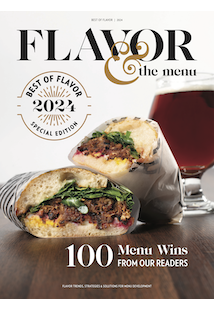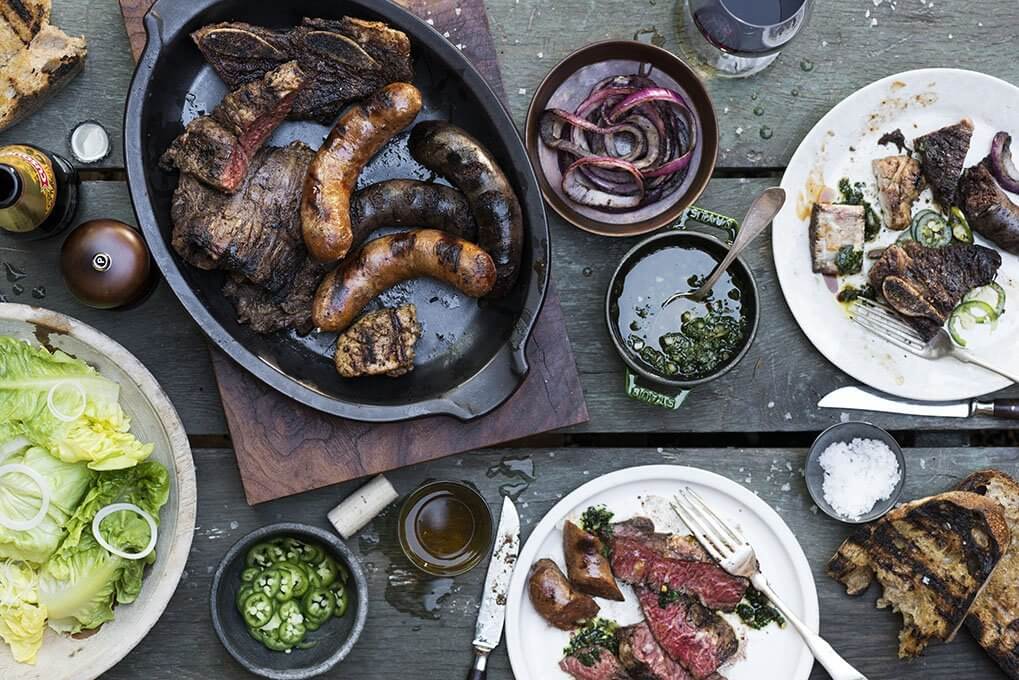Barbecue sure ain’t what it used to be. Yes, you can still find humble roadside shacks and celebrated old-line pitmaster joints, but the face of barbecue is changing. Like other cult favorite foods—think pizza, burgers, breakfast sandwiches—barbecue has come in for a whole new look by an emerging generation of young chefs determined to put their stamp on a classic.
“With the advent of tech information, barbecue is no longer a secret science—the kind of thing you must stay up 24 hours with a barbecue master to learn,” says Stephen Gerike, director of foodservice marketing and innovation for the National Pork Board. “There’s still a great tradition of second- and third-generation pitmasters at the top of their craft, but there are also ambitious younger folks who are eager to do barbecue technically right as well as very innovatively.”
This has created a kind of parallel universe of barbecue between the traditional and the more forward-looking. “Once you’ve mastered the techniques, you can apply almost any flavor set or concept to it,” says Gerike. This includes:
- Deconstructed barbecue, where the elements (low-temperature smoking, balance of sweet/sour/spicy flavors) are taken apart and put back together in a creative style
- Global concepts, including Cantonese, Southeast Asian, Japanese, Caribbean and South American
- Applying better culinary techniques (such as resting meat), ingredients (niche proteins) and presentation (attention to side dishes) to traditional barbecue
- Experimentation with different regional styles
- Using barbecue in less traditional ways, such as salads, bowls, appetizers and bar bites, as well as more elaborate signature sandwich builds
Elevating Authenticity
One thing that barbecue invariably invokes is a sense of authenticity—this is honest food, cooked in a traditional manner. But that doesn’t mean it can’t be elevated in ways that turn it into a serious dining experience.
At Chicago q, a seven-year-old Gold Coast bastion that is “not your ordinary barbecue joint,” the inspiration is competition barbecue served with such high-end trappings as a genteel Savannah-style dining room, a serious wine list and a selection of rare and exclusive bourbons touted to be the best in town.
“Our mission is ‘keep the flavor, elevate the experience,’” says Ian Thompson, chef de cuisine, who creates
specialties influenced by the iconic barbecue styles of the Carolinas, Texas, Missouri and Tennessee. Offerings include two kinds of ribs (baby backs and St. Louis), brisket, pulled pork, both smoked and pulled chicken, and an unusual pulled beef that appears in a sandwich.
Iconic signifiers like bark and a proper smoke ring are key goals, but the restaurant also sources hand-selected prime beef from regional farms, heritage pork butts, and Berkshire pork chops, according to Rey Villalobos, corporate executive chef for Ideology Entertainment, parent company of Chicago q, as well as Biggs, La Storia, and the Blue Door group of farm-to-table concepts. The basic idea is keeping it real in terms of authenticity and honesty, but doing it better with top-quality proteins, housemade rubs and sauces, and menu additions like Kale & Quinoa Salad, BBq Glazed Salmon, and a whole pork shoulder that is shredded by hand at the table for a party of 10 to 12.
There are also many appetizers and side dishes that extend the barbecue experience and help cross-utilize ingredients, including: q Brisket Meatballs; a “flight” of brisket; pulled pork and pulled chicken; Prime Brisket Burnt Ends; and the restaurant’s signature Pitmaster Mac ’n’ Cheese; which can be garnished with burnt ends, bacon, pulled pork or pulled chicken.
But these two chefs can still talk the finer points of ’cue with the best of them on the competition circuit. “Rubs are really important—not just for flavor but also because they help break down and tenderize meat,” says Villalobos, revealing that the beef rub is saltier than the pork one for a variety of subtle reasons. “Too much salt would make the ribs too bacony, changing the texture as it pulls the moisture in and then pushes it out. This is often overlooked.”
If barbecue is only salt, meat and heat, it’s still a science that needs to be developed by trial and error and then managed every day to account for variables in thickness, temperature, smoke and more. “We’re constantly checking, rotating, feeling, to make sure we always get it right,” says Thompson. Though they try to get briskets of consistent size and marbling, a few pounds’ difference can affect the final product. So can the type of wood available at any given time, as well as the resulting heat. “If there’s not enough wood and you don’t get enough smoke you don’t get the pellicle [smoke ring]. If there’s too much smoke the meat gets overcooked.” In addition, applying certain culinary techniques, like resting meat after it comes out of the smoker, affects the finished quality.

Barbecue styles and techniques can be endlessly adapted to suit modern-day menus.
Regional Style
Another big trend in barbecue is regionality. Wood Ranch BBQ & Grill is not a barbecue specialist per se, but it is an American restaurant that features regional barbecue items with a serious commitment to quality.
Alejandro Benes, culinary director and partner of the 16-location, California-based chain Wood Ranch, first started playing with barbecue fire in 2009, moving quickly beyond “can’t-lose tri-tip,” (a local specialty that’s also known as Santa Maria-style barbecue) and baby backs to answering customer demand for pulled pork. “That was an instant hit, and gave us the confidence to introduce more smoked meats,” says Benes, who grew up in North Carolina. “If you have the right equipment and the knowledge, smoking meat is really not that difficult—if you’re just one location,” adds Benes. “But for a chain, the challenge is multiplied by the number of units and the number of hands.”
Today the Signature BBQ section of the menu—which generates as much as 50 percent of sales—includes seven different styles of barbecue, including chicken, brisket, the more unusual beef back ribs, plus a BBQ Combo option. Wood Ranch also offers as a special its Giant Short Ribs—a real Texas thing, says Benes, dry-rubbed and smoked over pecan wood for hours as they render fat to blend with the meat and create a satisfying and deep, beefy flavor. While a traditional Texas rib is smoked until fairly dry, Benes aims for a more classic braised, shredding consistency and a sauce treatment that appeals to his customers, in which the ribs are sauced and finished over mesquite for a nice caramelization. “They can choose to have them without sauce, but that’s a small minority. Wood Ranch guests don’t dig dry barbecue—they like it saucy,” he says, highlighting a regional preference in barbecue style.

Dubbed “The Ultimate,” Wood Ranch’s new sandwich includes Carolina pulled pork, Carolina slaw, brisket, Swiss cheese, kielbasa, charred jalapeño and onion strings.
Noting that traditional barbecue started as a technique for making lower-quality meats and non-premium cuts not only edible but also delicious, Benes says that Wood Ranch is competing with many of today’s boutique barbecue purveyors by sourcing better meats, including Certified Angus Beef. It’s also taking the more labor-intensive route of trimming its own briskets—by far the most difficult cut to work with, according to the chef—from the packer’s cut, which contains both the flat and the point.
“We have to communicate our passion and commitment to quality to our staff. We do get it right most of the time, but it takes a lot of training and experience to produce good barbecue. You have to have people who are willing to figure out what went wrong and how to fix it,” he says. “If the brisket came out hard, do you lower the temperature? Do you wrap it? Those are the kinds of issues you encounter.”
The company goes to great lengths to maximize utilization of its barbecue products. Benes says you need a diverse audience to support varied barbecue offerings—which include the deckle or point section of the brisket. Benes says 90 percent of Californians prefer their brisket lean, so Wood Ranch uses the fattier point section in sandwiches. Pulled pork, chicken and tri-tip show up in sandwiches, salads and appetizers like the BBQ Chicken Potato Skins, and the concept recently added smoked pulled turkey breast to its barbecue program.
Now Wood Ranch is taking an even more deliberate move into barbecue innovation with the introduction of The Ultimate, a towering sandwich built of pulled pork, Carolina slaw, brisket, Swiss cheese, spicy grilled kielbasa, charred jalapeño and the concept’s Famous Shredded Onions on a toasted brioche bun. “It really appealed to the extreme-eating, Instagramming, hipster-crowd at the Burbank unit where we tested it, but now we’ve got it on every menu.”
Global Influences
Taken generically, barbecue exists all over the planet, from Latin America to Southeast Asia—in fact, it could be argued that barbecue is one of the world’s most indigenous foods. Not surprisingly, the barbecue that’s being translated here—with great success—follows the culinary traditions of what second-generation chefs and exploration-minded entrepreneurs are interested in, such as those traditions from Korea and the South American Pampas.
It was the grilling traditions of Argentina that Greg and Gabrielle Quiñónez Denton turned to in 2012 when they opened Ox, their asado-style steakhouse in Portland, Ore. Gabby Denton had spent summers in Quito growing up, and ate a lot of South American barbecue with friends in her hometown of Los Angeles. And both had fallen in love with the flavors and techniques of the wood-burning grill.
Central to their concept, in both the menu and the exhibition kitchen, is the enormous parrilla—a two-sided grill that raises and lowers by means of a hand-cranked system of wheels and pulleys—that is used to produce everything from traditional steaks to veg-centric specialties like grilled cauliflower with tahini-feta purée, fried lemon, arugula and pickled peppers. Their top-selling dish is the Asado Argentina, a combo plate for two that features a hit parade of grilled short rib, housemade chorizo and morcilla sausages, skirt steak and sweetbreads, with fried potatoes and a green salad for good measure.
“This is our interpretation of what Argentina does well: meat,” says Greg Denton, who interned in the dining room of the Central Intelligence Agency in Langley, Va.
But the wood-burning grill is more than just a place to cook ingredients. One of the signature touches that has made Ox one of the top-rated steakhouses in Portland is what the Dentons call “black gold,” made from the fat that drains off proteins into channels in the side of the grill. Like an infinity project, this rendered fat is collected in pans filled with lemon, garlic, herbs and onions, and used to baste or finish any number of other menu specialties—“our unique umami bomb,” says Gabby.
The Dentons use the grill, as well as the coals under it, to prep and cook a huge number of items on the menu, taking advantage of the heat that’s already there throughout the day. This includes bruschetta for appetizers, grilled broccoli and escarole for a white bean gratin, split artichokes, loose vegetables like green beans in a grill basket, even apples for a tres leches cake. Bone-in halibut is cooked directly on the coals in a basket, while the wood-fired trout is cooked under the firebox in a black-iron pan to create a broiling effect. “We could spend the rest of our lives learning new ways to harness the flavor and power of this cooking method,” says Denton.

Texas barbecued beef brisket is anchored in authenticity and prepared with time-honored technique, but can still be updated with improvised sauces and spices.
The Progressive Approach
The backdrop is San Antonio, the menu includes such highfalutin specialties as: smoked octopus with potato, morcilla sausage, chorizo oil and pimento; smoked pork shank with barbecued lentils, fennel and apricot; and Brisket Ramen garnished with smoked shoyu broth, brown ale noodles, onsen egg, ’cue shallots and crispy collards.
Welcome to The Granary ’Cue & Brew, a dual-concept barbecue spot, where chef-owner Timothy Rattray keeps feathers unruffled with butcher paper, barbecue plates, and smoked meats by the pound at lunch, but indulges his creative side with the likes of grilled quail vindaloo and smoked duck breast at dinner.
“I’m honoring the tradition of barbecue with Central Texas market-style service at lunch, but looking at the future of barbecue with the rest of the menu,” says Rattray, who grew up with backyard-smoked barbecue but trained at serious restaurants like San Antonio’s upscale Le Reve, Le Bernardin in New York and Schwa in Chicago, before returning home to San Antonio to go into business with his brewmaster brother, Alex.
At The Granary, the chef is all about fusing the techniques of traditional barbecue with the flavors and ingredients of a more innovative approach, pairing crispy, smoked pork ribs with tatsoi and a Thai dipping sauce, and grilled suckling pig with maple spoonbread, red currant gastrique and hazelnuts. His approach reflects a growing theme in foodservice today—one centered around modern American cuisines. There is roasted cauliflower with smoked cauliflower cream, braised greens and brown butter-honey vinaigrette, and the smoked duck breast comes with housemade mole negro, corn-benne fritters, pickled summer peppers and Brussels sprouts.
The signature Texas Toast appetizer consists of buttermilk bread grilled with “barbecue butter,” for which Rattray harvests the drippings from his multi-meat smoker, separates out the fat, and then infuses it into butter. First collected on a whim, this smoked meat essence has become a tool for experimentation wherever the chef wants to apply smoky barbecue flavor into food: added to miso for sauce, into brines, as a baste for the quail or for a hollandaise sauce that’s further goosed with beer.
Rattray runs a low-heat pit (215 to 225 degrees F, versus a more traditional 275 to 325 degrees) that goes 24/7. He also uses an all-purpose rub that puts his own spin on such traditional flavorings as chile powder: coffee, cumin, mustard powder and black pepper with a salt and brown sugar base. All of his meats are responsibly sourced, which has led to higher-than-average prices and a bit of sticker shock at lunch, but he sees his role, in part, as an educator of his customers. “I’m getting them to realize that there’s no reason we can’t do serious barbecue that’s also innovative and quality-oriented.”

This Southern Style Pork Butt surprises with a sweet potato mole and Mississippi Delta pork hot tamales.
Sides in the Spotlight
In the new barbecue game, sides are almost as important as the center-of-plate, says the National Pork Board’s Stephen Gerike. “There’s a realization that with barbecue—just as in everything else—you have to compose a meal that creates the whole experience. You need something fresh and crunchy to counter those rich, fatty, smoked proteins.” Menu examples include:
> BBQ Fried Rice with BBQ Meats
> Black-Eyed Peas with Kale
—Dinosaur Bar-B-Que, multiple locations
> Fried Brussels Sprouts
> Jalapeño Cheddar Grits
—DCity Smokehouse, Washington, D.C.
> Sweet Potato Tater Tots
> Fried Pickles with Smoked Aïoli
—Southpaw BBQ and Southern Cooking, San Francisco, Calif.
> Original Peanut Coleslaw
> Red Quinoa Almond Mix
—Wood Ranch BBQ & Grill, multiple locations in Southern California
> Apple Mustard Slaw
> Sweet Potato Waffle with Walnut, Bourbon and Maple
—Arrogant Swine, Brooklyn, N.Y.











